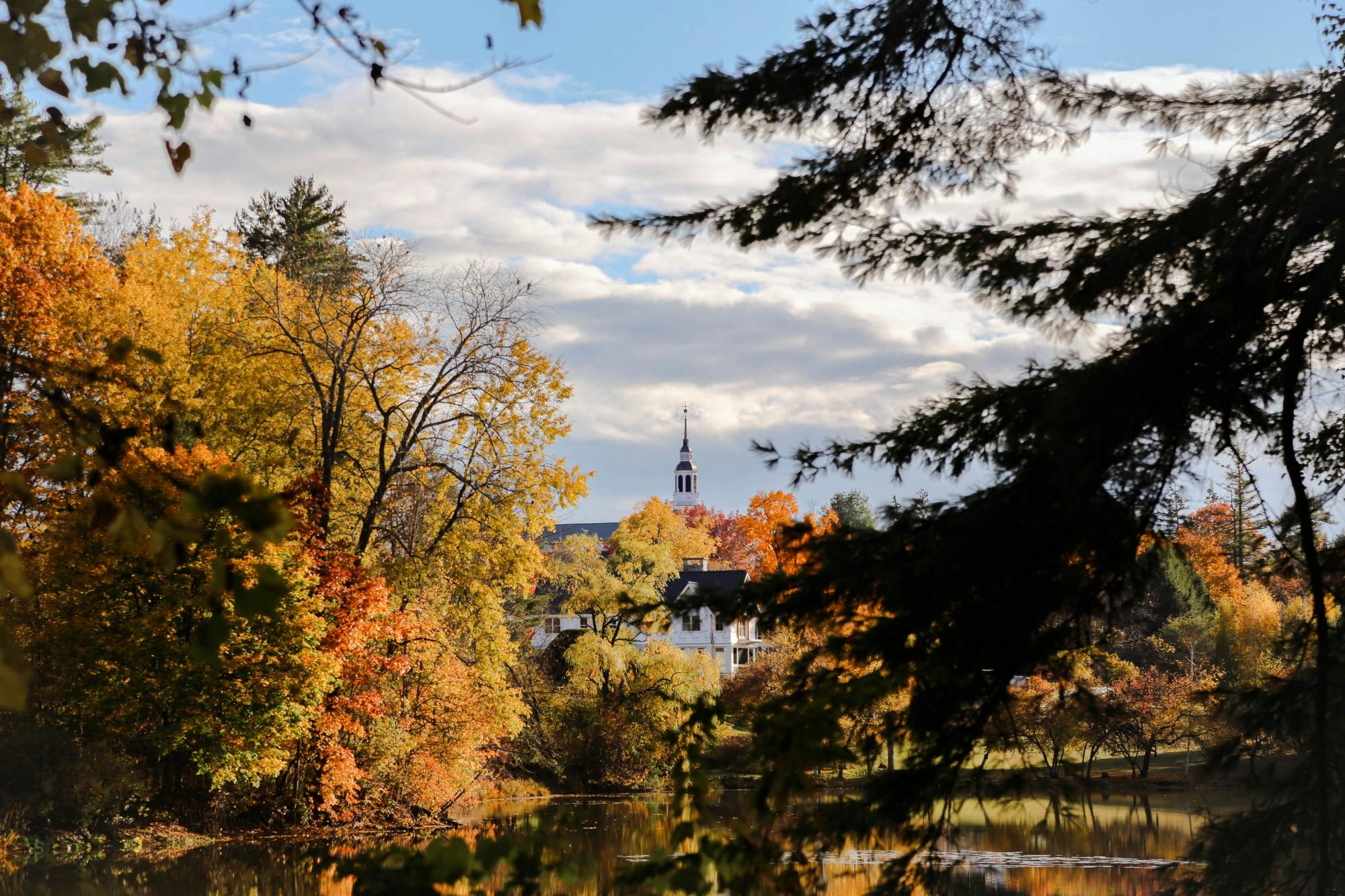This article is featured in the 2021 Commencement special issue.
The Lone Pine, formerly known as the Old Pine, embodies many facets of Dartmouth’s history, tradition and mythology. Originally standing in College Park, this pine was a gathering place for seniors in 1828, the location for Class Day in 1854 and is thought to have been a location where Native Americans would gather and sing. Although a lightning strike in 1887 ultimately spelled the end for this legendary pine, trees of all shapes and sizes remain omnipresent in and around Dartmouth’s campus and in College lore.
Dartmouth’s arboreal history, primarily rooted in the original Lone Pine, dates back to 1783 when the Old Pine was planted. While the famous white pine was cut down in the late 19th century after its ill-fated run-in with mother nature, the tree was ultimately replaced in 1967. That year, the Class of 1927 planted a new pine near Bema, naming it the “Dartmouth Pine.”
Campus arborist Brian Beaty, who looks after nearly 2,000 trees on Dartmouth’s campus, said that the deep, gravel and sand-rich soils in the area are a good growing medium for white and Austrian pine trees — making it easier for the conifers to grow tall. Beaty added that the significant height of Dartmouth’s healthy pines, however, can pose difficulties: Their size is a potential danger to those strolling campus in the wintertime.
“Nowadays, in the campus core, there aren't so many, because [the pines] just get so tall,” Beaty said. “They tend to drop their branches in the wintertime with snow, so people get afraid of them.”
Beaty added that today, the largest pine trees are not found on campus, but instead near the Connecticut River, in Pine Park and adjacent to the cemetery.
While pines have made their indelible mark on Dartmouth’s history, the oldest tree on campus is not a pine, but an American elm. This statuesque tree — pictured in West House’s seal — sits between the Russell Sage and Fahey dorm buildings and dates back to 1870.
The oak trees around the Hanover area also have a storied history, according to Beaty. There are more oaks — predominantly red, English and pin oaks — on campus than any other type of tree. Beaty noted that these hardwoods contribute to much of the famous colorful fall foliage on and around campus.
While a majority of the College’s trees are native to the area, some species, such as the flowering crabapple and the yellowwood trees, are not. These trees were planted for ornamental purposes, as is the case on many other college campuses, but the trees are also integrated among native species. Beaty said that this process allows native trees, such as the white pine, to be most prominent around campus, maintaining a natural, native landscape.
Craig Layne, a learning facilitator in the biological sciences department, said that yellowwoods — another of Dartmouth’s well-known trees — were thought to have been planted around campus due to their flowering times.
“[Yellowwoods] flower at the time of graduation, so there's a nice scent in the air,” Layne said. “I suspect that's why that's a popular tree around campus.”
According to Beaty, Dartmouth’s campus trees haven’t always fared successfully. A 1938 hurricane destroyed many of the older trees in the area. Further, he added, many trees have been lost to Dutch elm disease — a fungus that hit North America especially hard during the 1960s.
Biology professor Matt Ayres studies the ecology of the insect species inhabiting the trees around campus. He said the combination of the Dutch elm fungus, European bark beetles and American mites is responsible for the spread of Dutch elm disease.
According to Ayres, the fungus’s sticky spores make it easier for the pathogen to stick onto bark beetles that carry mites with them, allowing the disease to spread quickly through the tree. The mites, Ayres said, have pouches that allow them to carry these spores, which the critters use as a glue to attach themselves to the inside of the beetle wings and travel to neighboring trees.
“Many of the beetles — half or more — have one or more of these mites that are riding on them, catching a free ride,” Ayres said.
Dutch elm disease, which originated in the Himalayan region, came to America on wooden pallets and through live plants. Once it infects its host, the fungus can cause the tree’s stomata to malfunction, leading the tree to become permanently dehydrated.
According to Beaty, Dutch elm disease poses a constant threat to campus elms. As such, Beaty and others monitor the trees closely and work to protect them by planting genetically engineered trees resistant to fungus and pumping fungicide into the trees approximately every three years.
Ayres mentioned that another pest — the emerald ash borer, which entered Detroit from Asia 13 years ago — will likely cause all of the ash trees around campus to die in the next few years. Dartmouth’s hemlock trees, he also noted, are threatened by hemlock woolly adelgid insects that have been killing trees across the nation. Luckily, due to Hanover’s harsh winters, the trees in the area have so far survived the infestation, according to Ayres.
“There's a climatic barrier for the adelgids that they haven't been able to cross,” Ayres said. “However, the coldest nights of the winter are warming at an amazing rate.”
As a consequence, he predicted, most hemlocks will die out within the next 20-30 years.
Both Beaty and Layne added that significant time, money and planning goes into landscaping the campus’s trees, which face constant threats from drought, climate change, disease and construction. Beaty said that sugar maples — the primary source of the famous maple syrup of the area — have suffered acutely due to recent droughts.
Further, Beaty said, construction has created issues for Dartmouth’s campus trees. The College plans to heavily renovate many buildings and structures around campus over the next decade, making the task of protecting trees even more challenging.
“We have protection plans for most of the landscape, and most architects are aware of trees when they plan these buildings, but it's really still a hard time for us to defend the trees,” Beaty said.
The College’s campus trees are important not only for aesthetic reasons, but for the academic careers of Dartmouth students. Layne, who teaches the course BIOL 16, “Ecology” said that as part of the course, students track the annual cycles of trees growing around campus.
“Every student has a tree on campus that they have to follow the phenology of — in other words, the timing of the biological events of that tree,” Layne said.
The students will then compare the data collected with information from previous years to look for trends and changes in the tree record. Layne said that students are able to tell when a tree has suffered through a drought or a particularly cold spring through their data and compare their results to other changes in climate in the local area.
Students primarily follow red maple trees around campus due to their prevalence. By studying the trees and comparing data over the years, students are able to keep track of flowering times and leaf-outs from bud to blossom.
“The students like having a tree that they soon start to think of as ‘their’ tree,” Layne said.
Dartmouth’s trees don’t only provide intellectual fodder for students — they are also home to invertebrate species. Students in BIOL 16 are taught to observe the species present on the trees.
Layne said that oak trees play an especially important role for the 250-300 species of insects that inhabit them.
“A lot of caterpillars make use of those trees, so we'll see different butterflies on campus,” Layne said.
Ayres added that many other animal species now live in the area due to the trees that were planted on campus.
“There are chipmunks, red squirrels, gray squirrels, deer, turkeys, fishers — there have even been moose on campus,” Ayres said. “Dozens of bird species that we would definitely not have if it weren't for the trees as well.”
Students, too, appreciate the arboreal diversity present at the College. Earth sciences major Shannon Sartain ’21, who took BIOL 16 during her sophomore spring, said it was “one of the best” courses she has taken at Dartmouth.
“My favorite part was observing something up close — in Hanover, all of a sudden, it will be spring and it's really exciting,” Sartain said. “But to watch the process go from stick season in the winter to the leaves coming out in May was really fun for me.”

Manasi Singh '24 is from Cincinnati, Ohio. She is majoring in anthropology and politics, philosophy and economics. At The Dartmouth, she wrote for news and Mirror but later transitioned to the business staff. Manasi now serves as the Publisher.




